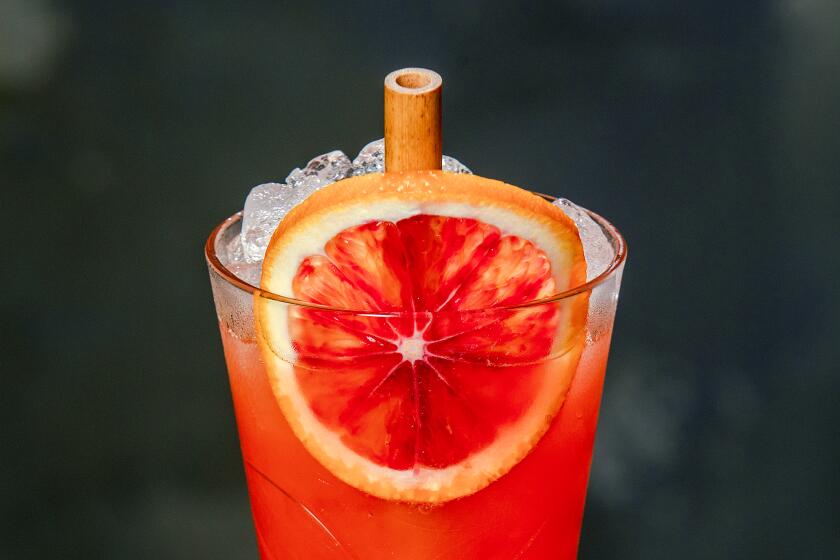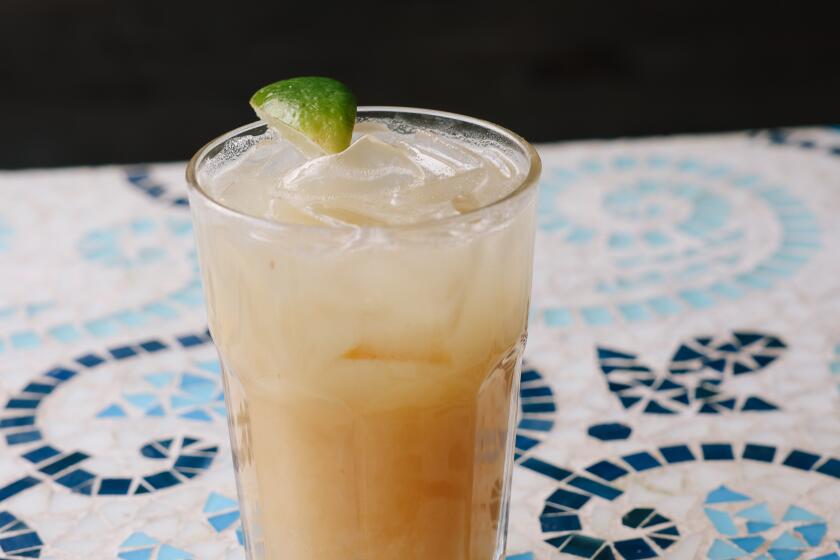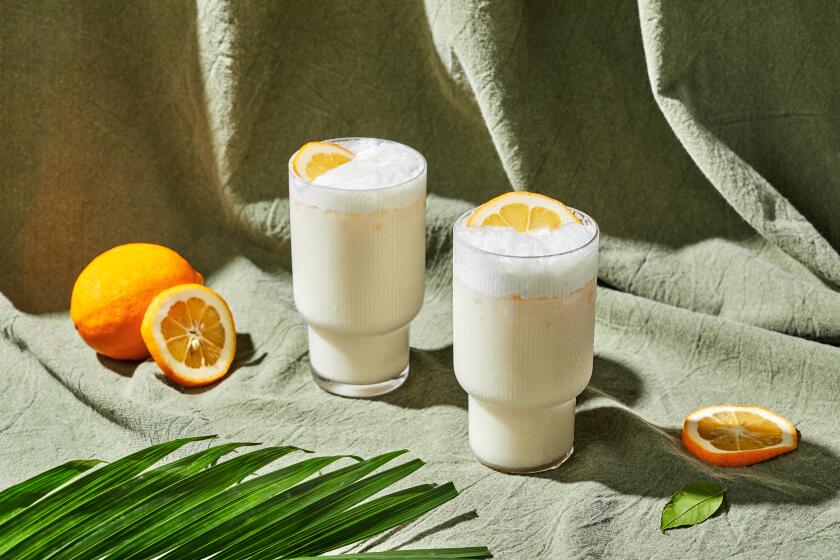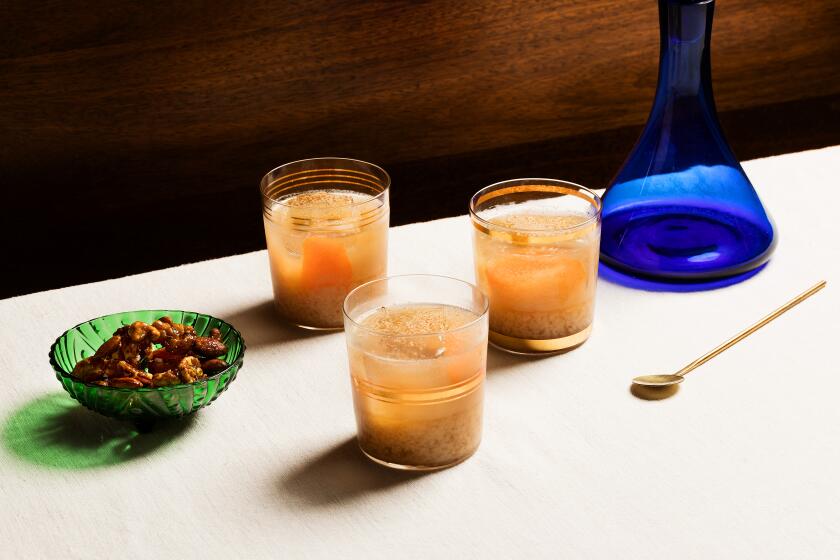Ward 8
Today a cornerstone will be laid here on the site of George Washington’s distillery, which is being rebuilt after 190 years of neglect. During Washington’s lifetime it produced as much as 11,000 gallons of whiskey a year, making it the largest distillery in the young nation.
Rye whiskey is what Washington made, so it’s fitting that the rebirth of his distillery comes at a time when there seems to be renewed interest in rye, which leapt from obscurity during the Revolution to become the country’s leading tipple. It was the patriotic drink; unlike rum, the favorite in Colonial days, rye required no trade with England.
Rye, the whiskey for which many classic cocktails were developed (such as the Manhattan, the Highball and the Ward 8) would remain the standard American whiskey until Prohibition, when smuggled Canadian whiskey took its place.
Even after repeal, many Americans continued to be rye drinkers. When the hard-boiled detective in an old movie reaches for the bottle he keeps in his desk drawer, you can be sure he’ll pull out a fifth of rye. In James M. Cain’s 1941 novel “Mildred Pierce,” the heroine asks for a whiskey and then gags when she tastes it because it turns out to be an unfamiliar drink called Scotch.
Today, it’s rye that would be unfamiliar to most people (though it contributes to the flavor of most Bourbons), but that may change. In recent years, there has been an unprecedented explosion of premium ryes, aged as long as 18 years.
Distilling was introduced to the colonies in the early 18th century by German and Scottish immigrants. They distilled anything that would ferment but eventually settled on a mixture of corn, the principal American grain, and rye, which was abundant in Maryland and Pennsylvania. Corn produces a relatively sweet whiskey; the colonial distillers evidently liked the backbone that rye gave the mix.
So while most of their fellow colonists were drinking rum or apple brandy, Marylanders and Pennsylvanians were developing their own distinctive whiskeys. In time, Maryland came to prefer a bright, grassy flavor, Pennsylvania a sweeter, more brooding style.
After the Whiskey Rebellion -- which erupted when President Washington (not yet a distiller himself) was persuaded to tax whiskey -- a number of rye makers headed west to evade the law. Rye proved harder to grow in Kentucky, so they used a higher proportion of corn, creating the sweeter whiskey we call Bourbon. Still, rye remained the favorite whiskey outside the South.
Washington’s distillery property is on Dogue Creek, about three miles south of his historic home and operated by the Mount Vernon Ladies’ Assn., which, with a donation from the Distilled Spirits Council of the U.S., plans to recreate it as it was in 1799. When it opens to the public next fall, it will be a museum and demonstration site where visitors can see how whiskey was made in the 18th century.
Mount Vernon archeologists spent several years excavating the area and establishing where the grain boiler and the five copper stills had been located. In the course of his research, archeologist Dennis Pogue came across records from which he could deduce Washington’s rye recipe. Two years ago, the Distilled Spirits Council recruited a dozen master distillers from several companies to collaborate on the making of a small batch of the whiskey on the Mount Vernon property. It turns out Washington made a pretty serious rye -- it’s 60% rye grain, the rest mostly corn, while today’s ryes can contain as little as 51% rye.
In the 1820s, people started aging rye. “Public taste had gotten more sophisticated,” says drinks writer David Wondrich. “The real popular epicurean spirit of the time was Cognac, which has always been aged. So whiskeys followed suit and started aging.”
Rye doesn’t improve for as long in barrel as Bourbon or Scotch does. “It tends to get a hot taste,” says Angela Travers of Buffalo Trace Distillery. Still, 19th century rye distillers, particularly in Pennsylvania, used brand names boasting of immense age, such as Old Jupiter, Old Autocrat, Good Old Guckenheimer’s and Antediluvian.
Today, many Americans have never even tasted a straight rye and have no idea what it’s like. The taste of rye bread won’t give you much of a clue; whiskeys don’t taste much like the grains they come from (who would say Scotch tastes like barley?). By the time the whiskey reaches you, the grain has been consumed by yeasts, which add their own flavors (every distillery has at least one super-secret strain of yeast that gives the house flavor). Then the whole fermenting mass has been torn apart by the violent process of fermentation, and the finished whiskey has been aged in wood barrels, which changes the flavor in often unpredictable ways.
Over and over, aficionados describe rye less as a flavor than as a personality. It has a feel, a profile, that you learn to discern. Despite delicate floral and grassy notes in some makes, it tends to give a bracing impression. It’s a whiskey to prepare you for the jungle of life.
These days, most bars don’t even stock rye. If you ask for it, they’re likely to pour a Canadian whiskey, perhaps because the typical Canadian blend did include substantial amounts of rye once upon a time. But today, Canadian typically contains no more rye than in Bourbon. Two tiny distilleries in the rye-growing province of Alberta do boast that they make straight ryes, but they’re not available here.
The most widely available American ryes are both made in Kentucky, though they follow the traditional Pennsylvania and Maryland styles. Jim Beam maintains a 185-year-old Pennsylvania brand, Old Overholt, and makes a Maryland-style rye under its own Beam label.
But real sipping ryes have been appearing on the market recently, mostly from bottlers such as Hirsch, Michter, Van Winkle and Black Maple Hill, which obtain their whiskey from various distillers and arrange for it to be aged long past the usual four years.
The San Francisco brand Old Potrero has gone the exact opposite direction, distilling a 100% rye whiskey (something Washington would have been unable to do, because rye malt was impossible to make with the technology of his time) that is aged as little as legally permitted. Old Potrero’s 18th Century Style Whiskey has spent only two years in barrel, giving a flavor that Washington would find more familiar than most of today’s ryes.
As for Washington’s rye -- when his distillery is restored, will we see a Mount Vernon brand of whiskey? It’s true that the operation is licensed to distill by both the state of Virginia and the Bureau of Alcohol, Tobacco, Firearms and Explosives, but Frank Coleman of the Distilled Spirits Council doubts that it will ever be anything but a demonstration site, because of state and federal liquor laws.
But how about that rye whiskey that was made two years ago from Washington’s recipe? It’s being aged on the Mount Vernon property in a small barrel made from the staves of a used Port barrel, on the principle that Washington is known to have enjoyed fortified wines, so he would probably have had some Port barrels on hand. Because of losses to evaporation over the last two years, and occasional samples to satisfy curiosity, only about five gallons are left. When it’s auctioned for charity in 2006, only 35 bottles will be available.
So you’re curious about what George Washington’s rye is like, right? Well, in color it’s a medium amber with reddish tones. Along with a little sweetness from the Port wood, it has a clean, hard-boiled rye flavor, which pops out even more with a splash of water.
Washington wouldn’t have aged this whiskey even two years. Still, it’s remarkably smooth for its age by the standards of our own time. And -- like all ryes, really -- it’s a remarkable link to the earliest days of our country, and a window on the vigorous tastes of the Revolutionary generation.
Pour the orange juice, lemon juice, rye and grenadine into a shaker filled with ice. Shake and pour into a cocktail glass.
Get our Cooking newsletter.
Your roundup of inspiring recipes and kitchen tricks.
You may occasionally receive promotional content from the Los Angeles Times.















